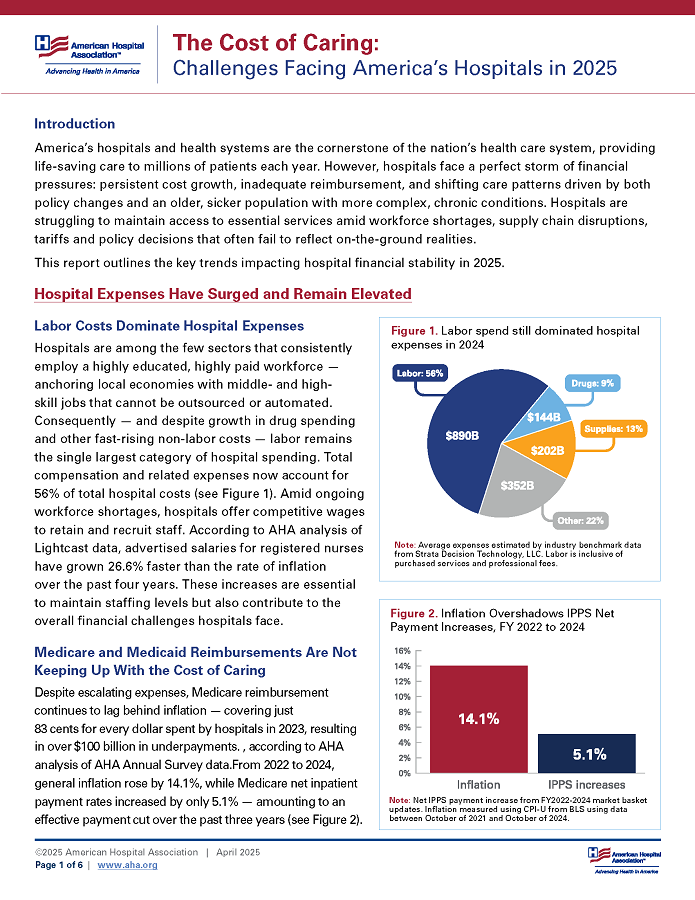

Costs of Caring
The Cost of Caring:
Challenges Facing America’s Hospitals in 2025
April 2025
Introduction
America’s hospitals and health systems are the cornerstone of the nation’s health care system, providing life-saving care to millions of patients each year. However, hospitals face a perfect storm of financial pressures: persistent cost growth, inadequate reimbursement, and shifting care patterns driven by both policy changes and an older, sicker population with more complex, chronic conditions. Hospitals are struggling to maintain access to essential services amid workforce shortages, supply chain disruptions, tariffs and policy decisions that often fail to reflect on-the-ground realities.
This report outlines the key trends impacting hospital financial stability in 2025.
Hospital Expenses Have Surged and Remain Elevated
Labor Costs Dominate Hospital Expenses
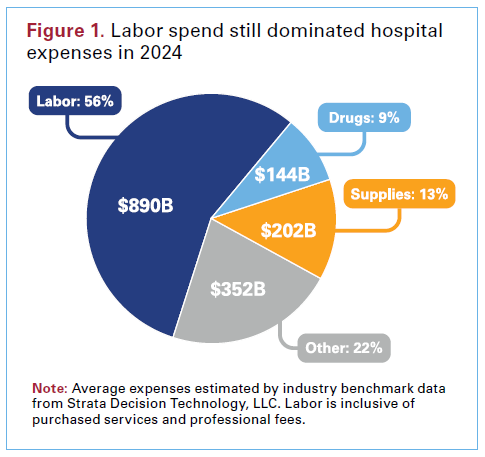 Hospitals are among the few sectors that consistently employ a highly educated, highly paid workforce — anchoring local economies with middle- and high-skill jobs that cannot be outsourced or automated. Consequently — and despite growth in drug spending and other fast-rising non-labor costs — labor remains the single largest category of hospital spending. Total compensation and related expenses now account for 56% of total hospital costs (see Figure 1). Amid ongoing workforce shortages, hospitals offer competitive wages to retain and recruit staff. According to AHA analysis of Lightcast data, advertised salaries for registered nurses have grown 26.6% faster than the rate of inflation over the past four years. These increases are essential to maintain staffing levels but also contribute to the overall financial challenges hospitals face.
Hospitals are among the few sectors that consistently employ a highly educated, highly paid workforce — anchoring local economies with middle- and high-skill jobs that cannot be outsourced or automated. Consequently — and despite growth in drug spending and other fast-rising non-labor costs — labor remains the single largest category of hospital spending. Total compensation and related expenses now account for 56% of total hospital costs (see Figure 1). Amid ongoing workforce shortages, hospitals offer competitive wages to retain and recruit staff. According to AHA analysis of Lightcast data, advertised salaries for registered nurses have grown 26.6% faster than the rate of inflation over the past four years. These increases are essential to maintain staffing levels but also contribute to the overall financial challenges hospitals face.
Medicare and Medicaid Reimbursements Are Not Keeping Up With the Cost of Caring
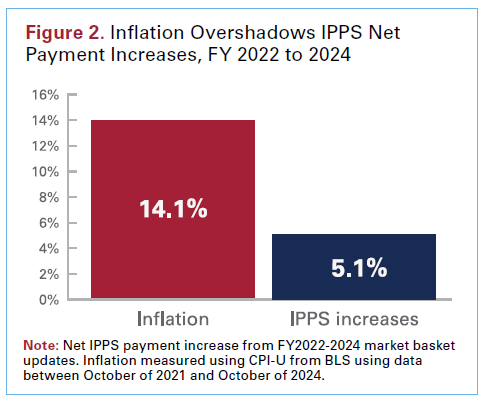 Despite escalating expenses, Medicare reimbursement continues to lag behind inflation — covering just 83 cents for every dollar spent by hospitals in 2023, resulting in over $100 billion in underpayments, according to AHA analysis of AHA Annual Survey data. From 2022 to 2024, general inflation rose by 14.1%, while Medicare net inpatient payment rates increased by only 5.1% — amounting to an effective payment cut over the past three years (see Figure 2).
Despite escalating expenses, Medicare reimbursement continues to lag behind inflation — covering just 83 cents for every dollar spent by hospitals in 2023, resulting in over $100 billion in underpayments, according to AHA analysis of AHA Annual Survey data. From 2022 to 2024, general inflation rose by 14.1%, while Medicare net inpatient payment rates increased by only 5.1% — amounting to an effective payment cut over the past three years (see Figure 2).
The AHA estimates that this erosion in payment value due to inflation resulted in $8.4 billion in lost hospital revenue during that period, further straining hospitals’ ability to care for Medicare beneficiaries, who make up a large share of most hospitals’ patients. In total, hospitals absorbed $130 billion in underpayments from Medicare and Medicaid in 2023 alone. These shortfalls are worsening — growing on average 14% annually between 2019 and 2023.
Hospital Expenses are Growing Faster Than Inflation
Specifically, in 2024 alone, total hospital expense grew 5.1%, significantly outpacing the overall inflation rate of 2.9%. Though expense growth has started to slow in 2025, it remains elevated — particularly in areas driven by labor and supply chain pressures. Persistent expense growth threatens hospitals’ solvency and their ability to sustain comprehensive services in the communities they serve. A telling indicator of this strain is the average age of plant — a measure of the age of hospital infrastructure — which has risen by more than 10% over the last two years, according to industry benchmark data from Strata Decision Technology, LLC. This trend suggests that hospitals are increasingly unable to reinvest in critical physical assets, such as medical equipment, operating rooms and facility upgrades. Delayed capital improvements not only jeopardize care quality but also hinder hospitals’ ability to keep pace with evolving health care standards and technology.
Impact of Chronic Disease Burden Costs Driven by Increased Utilization
Rising hospital costs are increasingly driven by higher utilization and acuity, especially among patients with chronic conditions. According to the Centers for Medicare & Medicaid Services (CMS), recent growth in spending on hospitals reflects increased service intensity and use.1 For example, emergency department (ED) visits related to heart failure increased 126.7% per capita between 2010 and 2019 (see Figure 3), with associated spending growing 177.2%. Similar patterns are observed for type 2 diabetes and acute renal failure — some of the costliest conditions in terms of patient health and resource use. These trends underscore the demand-side pressures fueling cost growth.
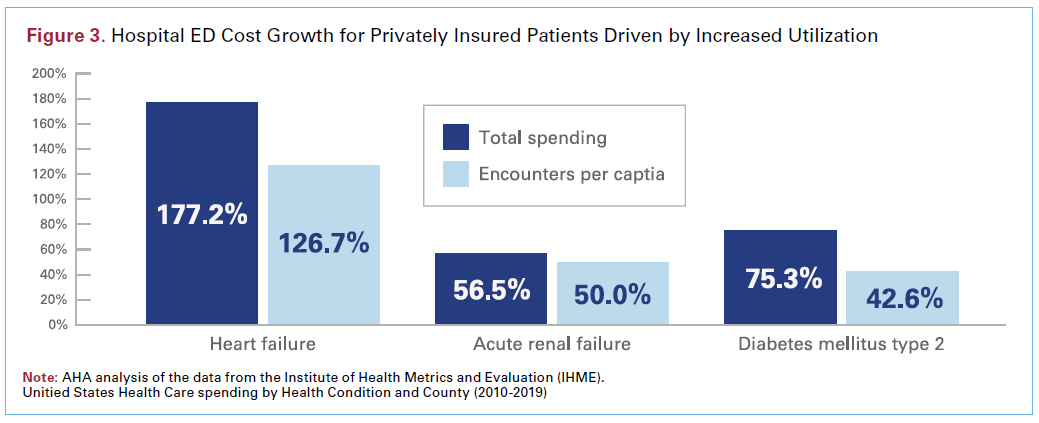
The Growing Impact of Medicare Advantage on Hospital Finances
Observation Stays Are Increasing in Duration
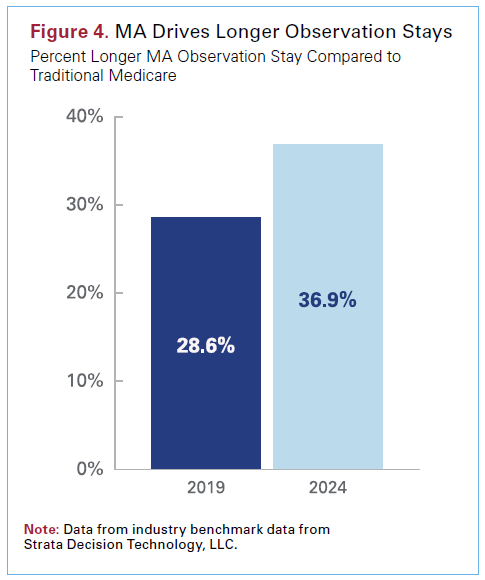 Medicare Advantage (MA) plans have long relied on extended observation stays to avoid admitting patients as inpatients — a strategy that helps plans reduce costs but shifts financial burden onto hospitals. Recent data show that this practice is worsening. In 2019, MA patients had observation stays 28.6% longer than those in Traditional Medicare; by 2024, the gap widened to 36.9% (see Figure 4). These prolonged observation stays drive up hospital costs without a corresponding increase in reimbursement, further straining hospital finances. Compared to inpatient admissions, observation stays are reimbursed at lower rates — or in some cases, not at all — leaving hospitals to absorb much of the cost. In 2024, MA plans reimbursed just 49% of the actual cost for patients held in observation status, according to industry benchmark data from Strata Decision Technology, LLC.
Medicare Advantage (MA) plans have long relied on extended observation stays to avoid admitting patients as inpatients — a strategy that helps plans reduce costs but shifts financial burden onto hospitals. Recent data show that this practice is worsening. In 2019, MA patients had observation stays 28.6% longer than those in Traditional Medicare; by 2024, the gap widened to 36.9% (see Figure 4). These prolonged observation stays drive up hospital costs without a corresponding increase in reimbursement, further straining hospital finances. Compared to inpatient admissions, observation stays are reimbursed at lower rates — or in some cases, not at all — leaving hospitals to absorb much of the cost. In 2024, MA plans reimbursed just 49% of the actual cost for patients held in observation status, according to industry benchmark data from Strata Decision Technology, LLC.
Longer Stays, Lower Payments
The inpatient setting reveals a similar pattern: longer stays for MA patients but with lower reimbursement. From 2019 to 2024, the average length of stay for MA patients grew substantially compared to Traditional Medicare — more than doubling the gap over this period, according to industry benchmark data from Strata Decision Technology, LLC. Yet during the same timeframe, hospital reimbursement from MA plans fell by 8.8% on a cost basis. In other words, hospitals are being asked to do more with less.
Discharge Delays Are Compounding the Problem
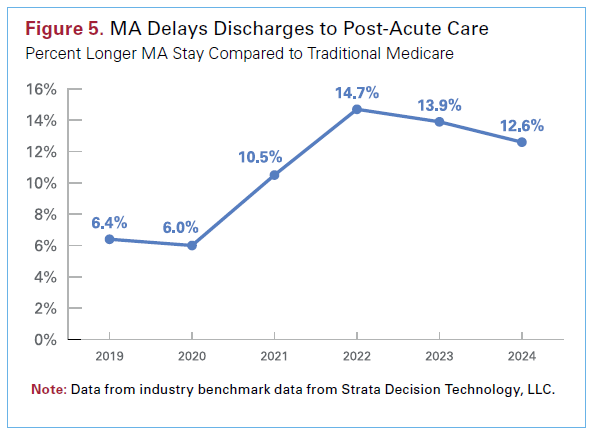 Delays in discharging patients to post-acute care facilities are a growing contributor to longer inpatient stays. These delays are often driven by prior authorization requirements or insufficient post-acute provider networks within MA plans. Among MA patients, the average length of stay prior to discharge to post-acute care has doubled relative to Traditional Medicare between 2019 and 2024 (see Figure 5). These delays lead to higher costs, increased hospital crowding — including in the emergency department — and longer lengths of stay. In some cases, plans may use these delays to steer patients toward lower-cost care settings — or avoid post-acute care altogether — while the hospital continues to absorb the cost of care. A Senate Permanent Subcommittee report recently found that some MA plans disproportionately imposed prior authorization and claim denials on post-acute care, exacerbating delays and shifting costs to hospitals.2 Post-acute care providers also have faced lagging reimbursement rates from Medicare, which has exacerbated staffing challenges and made it difficult to accommodate discharge requests from acute-care hospitals.
Delays in discharging patients to post-acute care facilities are a growing contributor to longer inpatient stays. These delays are often driven by prior authorization requirements or insufficient post-acute provider networks within MA plans. Among MA patients, the average length of stay prior to discharge to post-acute care has doubled relative to Traditional Medicare between 2019 and 2024 (see Figure 5). These delays lead to higher costs, increased hospital crowding — including in the emergency department — and longer lengths of stay. In some cases, plans may use these delays to steer patients toward lower-cost care settings — or avoid post-acute care altogether — while the hospital continues to absorb the cost of care. A Senate Permanent Subcommittee report recently found that some MA plans disproportionately imposed prior authorization and claim denials on post-acute care, exacerbating delays and shifting costs to hospitals.2 Post-acute care providers also have faced lagging reimbursement rates from Medicare, which has exacerbated staffing challenges and made it difficult to accommodate discharge requests from acute-care hospitals.
Lower Reimbursement and Increasing Administrative Burden
Hospitals are increasingly reporting lower negotiated MA rates than Traditional Medicare for many common inpatient services (see Figure 6). These discrepancies continue to create significant financial challenges for hospitals, especially for those in rural areas that have seen relatively fast growth in the volume of MA beneficiaries in recent years.3

At the same time, administrative complexity continues to increase. MA plans issued nearly 50 million prior authorizations in 2023 — up more than 40% since 2020, according to KFF.4 A Premier study found that hospitals spent $26 billion in 2023 managing insurance claims — a 23% increase over the previous year.5
Notably, 70% of denied claims were eventually paid, but only after multiple costly reviews. These burdens not only strain hospitals financially but also delay care and divert clinical staff from patient care. A Morning Consult survey commissioned by the AHA found that 85% of clinicians report that prior authorization and other requirements delay necessary care.
Impact of Tariffs on Hospital Costs
Hospitals and health systems rely on the right medicines, devices and other supplies used at the right time to support the delivery of safe and effective care. The supply chain for these essential medical goods is complex, weaving together both domestic and international sourcing, and is prone to significant disruption. For example, as of March 2025, there were 270 active drug shortages in the U.S., including shortages of life-saving intravenous (IV) fluids stemming from Hurricane Helene in 2024.6 Recent changes in U.S. trade policy are creating additional uncertainty, with the Administration implementing new tariffs that affect medical devices and supplies, and considering new tariffs on pharmaceuticals. Tariffs on these critical goods could exacerbate shortages, disrupt patient care and raise costs for hospitals.
Despite efforts to bolster the domestic supply chain, a significant proportion of essential medical goods come from international sources. For example, nearly 70% of medical devices marketed in the U.S. are manufactured exclusively overseas.7 In 2024 alone, the U.S. imported over $75 billion in medical devices and supplies, according to AHA analysis of Census Bureau data. These imports include many lowmargin, high-use essentials in hospital settings — such as syringes, needles, blood pressure cuffs, and IV saline bags. Hospitals rely on imports for advanced surgical tools and other critical technologies as well.
Moreover, hospitals rely on international sources for a significant proportion of the protective equipment for their caregivers. In 2023, Chinese manufacturers supplied the majority of N95 and other respirators used in health care. Additionally, China was the source for one-third of disposable face masks, two-thirds of non-disposable face masks, and 94% of the plastic gloves used in health care settings.8
Many pharmaceuticals — and especially the key starter ingredients that go into them — also are sourced from overseas. The U.S. gets nearly 30% of its active pharmaceutical ingredients (APIs) from China.9 According to a 2023 Department of Health and Human Services estimate, over 90% of generic sterile injectable drugs — such as certain chemotherapy treatments and antibiotics — depend on key starter materials from either India or China.10 Even temporary disruptions in access to medication and supplies can impact care and increase the risk of patient harm.
Tariffs on medical imports could significantly raise costs for hospitals. A recent survey found that 82% of health care experts expect tariff-related expenses to raise hospital costs by at least 15% over the next six months, and 94% of health care administrators expected to delay equipment upgrades to manage financial strain.11 Tariffs also may force hospitals to seek new vendors — often at higher cost or with lower reliability. In fact, 90% of supply chain professionals are expecting procurement disruptions.12
Conclusion: Supporting Hospitals Means Supporting Patients
Hospitals are not only centers of care but also vital economic engines in their communities. Rising costs, inadequate reimbursement, and policy-driven inefficiencies jeopardize the ability of hospitals to deliver high-quality, timely care. To ensure that hospitals can continue to serve patients and communities, policymakers should:
- Recognize that rising expenses reflect real pressures, such as labor shortages and increasing demand — not inefficiency.
- Acknowledge Medicare and MA payment policies must be updated to reflect the actual cost of care.
- Address structural drivers of cost, such as care delays and excessive administrative burdens, instead of simply cutting payments.
As we look to the future, preserving access to hospital care should be a national priority. Supporting hospitals means supporting patients, communities and the entire health care system.
Notes
- healthaffairs.org/doi/10.1377/hlthaff.2024.01375
- hsgac.senate.gov/wp-content/uploads/2024.10.17-PSI-Majority-Staff-Report-on-Medicare-Advantage.pdf
- aha.org/system/files/media/file/2025/02/growing-impact-of-medicare-advantage-on-rural-hospitals.pdf
- kff.org/medicare/issue-brief/nearly-50-million-prior-authorization-requests-were-sent-to-medicare-advantage-insurers-in-2023/
- premierinc.com/newsroom/blog/claims-adjudication-costs-providers-25-7-billion
- ashp.org/drug-shortages/shortage-resources/drug-shortages-statistics?loginreturnUrl=SSOCheckOnly
- medicaldevice-network.com/analyst-comment/trump-tariffs-us-medical-device-market/
- AdvaMed presentation, 2023.
- atlanticcouncil.org/blogs/econographics/the-us-is-relying-more-on-china-for-pharmaceuticals-and-vice-versa/
- aspe.hhs.gov/sites/default/files/documents/3a9df8acf50e7fda2e443f025d51d038/HHS-White-Paper-Preventing-Shortages-Supply-Chain-Vulnerabilities.pdf
- beckershospitalreview.com/supply-chain/hospital-finance-supply-leaders-predict-15-increase-in-tariff-related-costs/
- beckershospitalreview.com/supply-chain/hospital-finance-supply-leaders-predict-15-increase-in-tariff-related-costs/


